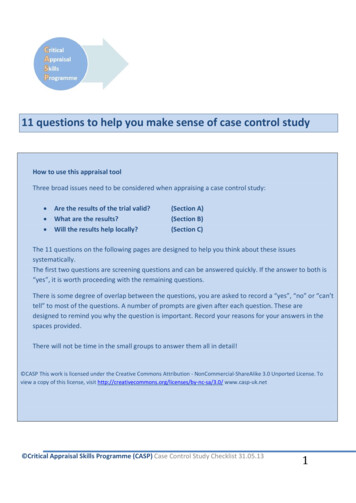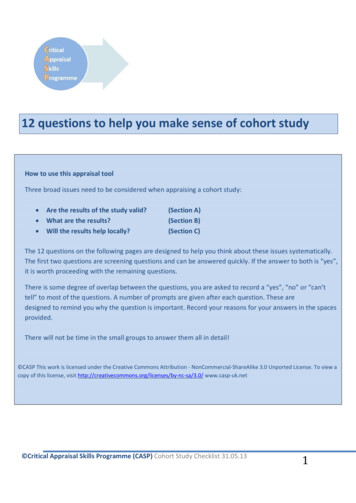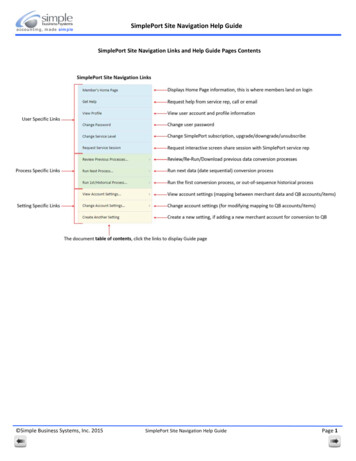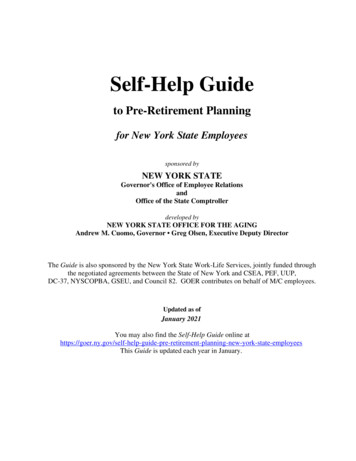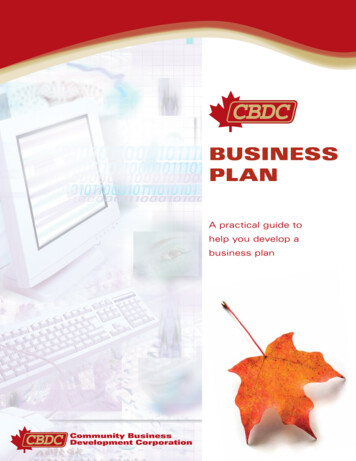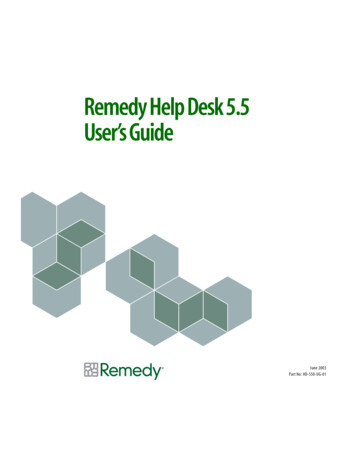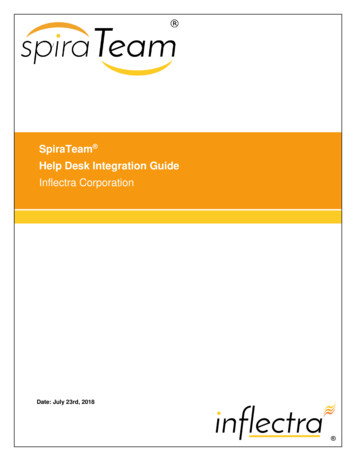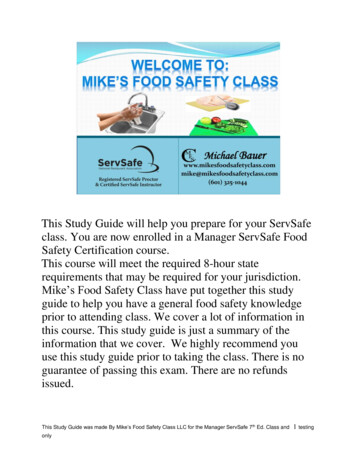
Transcription
This Study Guide will help you prepare for your ServSafeclass. You are now enrolled in a Manager ServSafe FoodSafety Certification course.This course will meet the required 8-hour staterequirements that may be required for your jurisdiction.Mike’s Food Safety Class have put together this studyguide to help you have a general food safety knowledgeprior to attending class. We cover a lot of information inthis course. This study guide is just a summary of theinformation that we cover. We highly recommend youuse this study guide prior to taking the class. There is noguarantee of passing this exam. There are no refundsissued.This Study Guide was made By Mike’s Food Safety Class LLC for the Manager ServSafe 7 th Ed. Class andonly1 testing
Chapter 1 Study guideWho needs to be Certified?The requirement is that the person in charge must become a Certified FoodProtection Manager.The FDA Food Code requires that the person in charge of a foodservice operationbecome a Certified Food Protection Manager. That person must always be onsiteduring operating hours. A Certified Food Protection Manager must show that he or shehas the required knowledge by passing a test from an accredited program. Theprogram must be accredited by an agency approved by a Conference for FoodProtection.Completing the ServSafe Manager Course and passing the ServSafe Food ProtectionManager Certification Examination meets this requirement.Why is it so important to become certified?Centers for Disease Control and Prevention study suggests that the presence of aCertified Food Protection Manager reduces the risk of a foodborne illness outbreak foran establishment. The study also suggests that it was a distinguishing factor betweenrestaurants that experienced a foodborne illness outbreak and those that had not.In addition, the FDA’s Retail Food Risk Factor Studies suggest that the presence of acertified manager has a positive correlation with more effective control of certain riskfactors, such as poor personal hygiene, in different facility types.Challenges to Food SafetyA food borne illness is a disease transmitted to people through food.An illness is considered an outbreak when: Two or more people have the same symptoms after eating the same food.An investigation is conducted by state and local regulatory authorities.The outbreak is confirmed by laboratory analysis.The biggest challenges we must overcome in food safety are: Time and Money – Pressure to work quickly can make it hard to take the time tofollow food safety practicesThis Study Guide was made By Mike’s Food Safety Class LLC for the Manager ServSafe 7 th Ed. Class andonly2 testing
Language and Culture - Your staff may speak a different language than you do,which can make it difficult to communicate. Cultural differences can also influencehow food handlers view food safety. Literacy and Education - Staff often have different levels of education, making itmore challenging to teach them food safety Pathogens - Illness-causing microorganisms are more frequently found on food thatonce was considered safe. Unapproved suppliers - Food that is received from suppliers that are not practicingfood safety can cause a foodborne-illness outbreak. High-risk customers - The number of customers at high risk for getting a foodborneillness is increasing. An example of this is the growing elderly population. Staff turnover - Training new staff leaves less time for food safety trainingCosts of foodborne IllnessLoss of customers and sales Loss of reputationNegative media exposure Lowered staff moraleLawsuits and legal feesStaff missing workIncreased Insurance Premiums, Staff retraining, and even death.The ServSafe program will provide the tools needed to overcome thechallenges in managing a good food safety program.If food is not handled correctly, it can become unsafe. These are the fivemost common food-handling mistakes, or risk factors, that can causefoodborne illness.1.2.3.4.5.Purchasing food from unsafe sourcesFailing to cook food correctlyHolding food at incorrect temperaturesUsing contaminated equipmentPracticing poor personal hygieneThis Study Guide was made By Mike’s Food Safety Class LLC for the Manager ServSafe 7 th Ed. Class andonly3 testing
Except for purchasing food from unsafe sources, each risk factor forfoodborne illness is related to four main factors:Time-temperature abuse - When food has stayed too long at temperatures goodfor pathogen growth. Food has been time-temperature abused when: It has not been held or stored at correct temperatures It is not cooked or reheated enough to kill pathogens It is not cooled correctlyCross-contamination - When pathogens are transferred from one surface or foodto another. Cross-contamination can cause a foodborne illness when: Contaminated ingredients are added to food that receives no further cooking Ready-to-eat food touches contaminated surfaces A food handler touches contaminated food and then touches ready-to-eat food Contaminated cleaning cloths touch food-contact surfacesPoor personal hygiene - Poor personal hygiene can cause a foodborne illnesswhen food handlers: Fail to wash their hands correctly after using the restroom Cough or sneeze on food Touch or scratch wounds and then touch food Work while sickPoor cleaning and sanitizing - Equipment and utensils are not washed,rinsed, and sanitized between uses. Food-contact surfaces are wiped clean instead of being washed,rinsed, and sanitized Wiping cloths are not stored in a sanitizer solution between uses Sanitizer solution was not prepared correctlyTCS foods are foods that do need time and temperature to keep them safeTCS Temperature Control for Safety. The list of TCS food includes the following: Milk and dairy products Shell eggs (except those treated to eliminate Salmonella spp.) Meat: beef, pork, and lamb Poultry Fish Shellfish and crustaceansThis Study Guide was made By Mike’s Food Safety Class LLC for the Manager ServSafe 7 th Ed. Class andonly4 testing
Baked potatoesHeat-treated plant food, such as cooked rice, beans, and vegetablesTofu or other soy protein; synthetic ingredients, such as textured soyprotein in meat alternativesSprouts and sprout seedsSliced melons; cut tomatoes; cut leafy greensUntreated garlic-and-oil mixturesReady-to-eat food is food that can be eaten without further: Preparation Washing CookingReady-to-eat food includes: Cooked food Washed fruit and vegetables Deli meat Bakery items Sugar, spices, and seasoningsPopulations at High Risk for Foodborne IllnessesThese people have a higher risk of getting a foodborne illness:1. Elderly people - Elderly people are at high risk because theirimmune systems have weakened with age.2. Preschool-age children - Very young children are at high riskbecause they have not built up strong immune systems.3. People with compromised immune systems - People withcompromised immune systems include: People with cancer or on chemotherapyPeople with HIV/AIDSTransplant recipientsPeople taking certain medicationsManagers must set up standard operating procedures that focus on themeasures listed above. Then they must train their staff on theseprocedures and monitor them to make sure the procedures are followed.This Study Guide was made By Mike’s Food Safety Class LLC for the Manager ServSafe 7 th Ed. Class andonly5 testing
Keeping Food SafeFocus on these measures: Controlling time and temperaturePreventing cross-contaminationPracticing personal hygienePurchasing from approved, reputable suppliersCleaning and sanitizingTraining and monitoring: Train staff to follow food safety procedures Provide initial and ongoing training Provide all staff with general food safety knowledge Provide job specific food safety training Retrain staff regularly Monitor staff to make sure they are following procedures Document trainingGovernment agencies: The Food and Drug Administration (FDA) - The Food and DrugAdministration (FDA) inspects all food except meat, poultry, and eggs. Theagency also regulates food transported across state lines. In addition, theagency issues the FDA Food Code, which provides recommendations forfood safety regulations U.S. Department of Agriculture (USDA) - The U.S. Department ofAgriculture (USDA) regulates and inspects meat, poultry, and eggs. It alsoregulates food that crosses state boundaries or involves more than onestate. Centers for Disease Control and Prevention (CDC) - conduct researchinto the causes of foodborne-illness outbreaks. U.S. Public Health Service (PHS) - conduct research into the causes offoodborne-illness outbreaks. State and local regulatory authorities - State and local regulatoryauthorities write or adopt code that regulates retail and foodserviceoperations. OSHA - Regulate your MSDS / SDSThis Study Guide was made By Mike’s Food Safety Class LLC for the Manager ServSafe 7 th Ed. Class andonly6 testing
Chapter 2 Study guideThere are three categories that food contamination falls in Biological, Chemical,and Physical.How Contamination HappensContaminants come from a variety of places: Animals we use for food Air, contaminated water, and dirto Contaminants can cause foodborne illness or result in physical injury.Contaminants are found in the animals we use for food, the air, water, dirt;and they occur naturally in food, such as bones in fishPeople Deliberately - Food can be contaminated on purpose.Accidentally - Most food is contaminated accidently.Examples of accidental contamination include food handlers who do not wash theirhands after using the restroom, and then contaminate food and surfaces with fecesfrom their fingers; and food handlers who pass contaminants through illness .People can contaminate food when: They do not wash their hands after using the restroomThey are in contact with a person who is sickThey sneeze or vomit onto food or food-contact surfacesThey touch dirty food-contact surfaces and equipment and then touch foodThere are three categories that food contamination falls in Biological, Chemical,and Physical.Biological ContaminationBiological contamination occurs when harmful microorganisms, referred to aspathogens, contaminate food.Microorganism: Small, living organism that can be seen only with a microscopeThis Study Guide was made By Mike’s Food Safety Class LLC for the Manager ServSafe 7 th Ed. Class andonly7 testing
Pathogen: Harmful microorganism Makes people sick when eaten or produces toxins that cause illnessToxin: PoisonFour types of pathogens can contaminate food and cause foodborne illness: BacteriaVirusesParasitesFungiCommon symptoms of foodborne illness: DiarrheaVomitingFeverNauseaAbdominal crampsJaundice (yellowing of skin and eyes)The symptoms of a foodborne illness vary depending on which illness a person has. Butmost victims of foodborne illness share some common symptoms.Not every person who is sick from a foodborne illness will have all these symptoms. Norare the symptoms of a foodborne illness limited to this list.Onset times: Depend on the type of foodborne illnessCan range from 30 minutes to six weeksHow quickly foodborne-illness symptoms appear in a person is known as the onset timeof the illness. Onset times depend on the type of foodborne illness a person has. Theycan range from 30 minutes to as long as six weeks. How severe the illness is can alsovary, from mild diarrhea to death.Bacteria: Basic CharacteristicsLocation: Found almost everywhere Detection: Cannot be seen, smelled, or tasted Growth: Will grow rapidly if FAT TOM conditions are correctThis Study Guide was made By Mike’s Food Safety Class LLC for the Manager ServSafe 7 th Ed. Class andonly8 testing
Prevention: Control time and temperatureBacteria live in our bodies. Some types of bacteria keep us healthy, while otherscause illness.The most important way to prevent bacteria from causing foodborne illness is tocontrol time and temperature.Bacteria need six conditions to grow. You can remember these conditions bythinking of the words FAT TOM. Food - Most bacteria need nutrients to survive. TCS food supports the growth ofbacteria better than other types of foodAcidity - Bacteria grow best in food that contains little or no acid. The pH scaleranges from 0 to 14.0. A value of 0 is highly acidic, while a value of 14 is highlyalkaline. A pH of 7 is neutral. Bacteria grow best in food that is neutral to slightlyacidic. The Rage for Bacteria growth is 4.6 to 7.5 on the PH scale.Temperature - Bacteria grow rapidly between 41 F and 135 F (5 C and 57 C)This range is known as the temperature danger zone. Bacteria growth islimited when food is held above or below the temperature danger zone. Bacteriagrow even more rapidly from 70 F to 125 F (21 C to 52 C).Time - Bacteria need time to grow. The more time bacteria spend in thetemperature danger zone, the greater chance they have to grow to unsafe levelsOxygen - Some bacteria need oxygen to grow, while others grow when oxygenis not thereMoisture - Bacteria grow well in food with high levels of moisture. aw wateractivity; the amount of moisture available in food for bacterial growth. aw scaleranges from 0.0 to 1.0. Water has a water activity of 1.0. The amount of moistureavailable in food is called water activity (aw). The aw scale ranges from 0.0 to1.0. The higher the value, the more available moisture in the food.Temperature and time are the two important conditions for growth that can be controlledin the operationNow we need to know about the BIG SIX. Salmonella Typhi - Bacteria Nontyphoidal Salmonella - Bacteria Shigella - Bacteria Shiga toxin producing Escherichia coli (aka E. Coli) - Bacteria Hepatitis A - Virus Norovirus - VitusThis Study Guide was made By Mike’s Food Safety Class LLC for the Manager ServSafe 7 th Ed. Class andonly9 testing
Bacteria: Salmonella Typhi (SAL-me-NEL-uh TI-fee) Source: PeopleFood Linked with the BacteriaPrevention Measures Ready-to-eat foodBev
This Study Guide was made By Mike’s Food Safety Class LLC for the Manager ServSafe 7th Ed. Class and 1 testing only This Study Guide will help you prepare for your ServSafe class. You are now enrolled in a Manager ServSafe Food Safety Certification course. This course will meet the required 8-hour state requirements that may be required for your jurisdiction. Mike’s Food Safety Class have .

